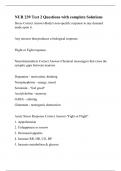Samenvatting
Thomas More - Micro Economics - Comprehensive Summary + Excercises and Solutions
- Vak
- Micro Economics
- Instelling
- Thomas More Hogeschool (tmhs)
THIS SUMMARY CONTAINS ALL EXERCISES + SOLUTIONS, ALL GRAPHS, AND COMPREHENSIVE EXPLANATIONS ON EVERYTHING School: Thomas More Course: Micro Economics Lecturer: Buyse Tim Content: Economics and opportunity cost - Schools of Economic Thought - Supply & Demand – Elasticity & Consumer / Produ...
[Meer zien]











